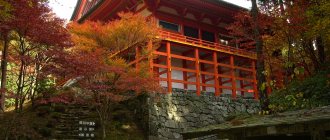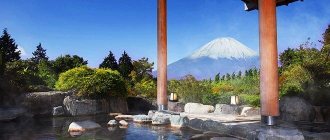Stone lanterns are part of Japan's cultural heritage and one of the most important elements of an oriental-style garden. This elegant, meaningful decoration not only creates a calm, soulful atmosphere, but also illuminates the area with a pleasant soft light.
As a rule, a Japanese stone lantern consists of five main parts (but not all types necessarily have them). The base symbolizes the earth, the support - water, the place for the candle - fire, the roof - the wind, the top (onion) - the sky. To install this decorative element, it is not necessary to decorate the entire area in Japanese style: create a small landscape module in which suitable trees, shrubs and flowers will grow.
EVERYTHING YOU NEED FOR THIS ARTICLE IS HERE >>>
Oki-gata
Compact lamp (no more than 40 cm in height), therefore used in small gardens. Most often, these lanterns are placed near flower beds and narrow paths, near shallow water or a dry stream, in the courtyard of a house.
ON A NOTE
Stone lanterns look organic against the background of rhododendron, Rogers, weeping willow, bamboo, bindweed, moss, lichen, hawthorn, weigela, deutzia, tree peonies, barberry, spirea, Schisandra chinensis, actinidia, wood pliers, Korean fir, Japanese larch, thuja, pine , spruce, fern, hosta, feather grass, fescue, miscanthus, irises, daylily, chrysanthemum, astilbe, azalea, bird cherry, lilac, quince, pieris, cinquefoil, kalmia. An extraordinary decoration of the site can be nivaki - plants grown in a special way with a beautiful extravagant crown.
Tsukubai and the “dry stream”
When arranging a Japanese garden with your own hands, do not forget about tsukubai (this is a stone bowl filled with water, made in the form of a barrel; the height of this bowl should not exceed 30 cm, but in some cases the height can reach up to 60 cm). In Japan, it is customary to wash your hands in such a bowl before starting the tea ceremony, which is one of the elements of Japanese culture. In most cases, tsukubai are placed on a small area, which is located in the center of the garden, near a hedge or a stone wall. It will look very impressive if you install a stone lantern near such a bowl.
When planning a Japanese garden, you should decide on the style direction; the choice of flowers and shrubs also depends on this.
“”, which is a mountain stream of small stones, looks very beautiful, but it can look like a calm expanse of water. In this regard, everything depends on how to lay the stones; their sizes also matter.
It is impossible to imagine a Japanese garden without a pond, and special attention should be paid to the design of its banks. You can create real masterpieces on the smooth surface of water; this is achieved thanks to the reflectivity of water. As for the water level in the pond, it must be equal to the shore, and the shape of the pond must be irregular. You can have small islands covered with trees and various kinds of vegetation; you can include a stone tower in such a composition.
A Japanese garden can be decorated with bridges that look very picturesque and stylish; they pass under dry or water streams. If you are making a garden with a natural landscape, then it is preferable to use rough wooden planks for bridges, but flat stone slabs can also be used. If there are compositions made of stone in the garden, then a bridge made of a rough stone slab looks very impressive.
Japan has many diverse and beautiful gardens, which amaze with their proportions and combinations of selected materials. can be called a small piece of the Japanese landscape, and every detail of this miniature model impresses with its special landscape. Not the least place in any garden is occupied by various garden structures. Typically, they are made from materials such as clay, stones, bamboo, metal, and wood.
In Japan, the use of (a symbol of nobility) in various decorative compositions adds a special sophistication to them, which fits perfectly into a garden that is thought out to the smallest detail. To do this, it is not processed and most often the bark is not even removed. But the Japanese prefer to use stones only those that have an irregular and unusual shape. After all, as you know, in nature there are no stones of ideal size and appearance. Although, if necessary, it is possible to slightly change their shape. Instead of clay, tiles are sometimes used in Japan, while concrete is used only mixed with other natural materials.
Japanese gardens are decorated with the following structures: fences, benches and stone lanterns (lamp). This, of course, is not the entire list of decorative garden elements.
Japanese stone lanterns are placed in various places in the garden, in particular along the edges of paths crossing the garden; near bridges and bridges; at the edge; near traditional structures - tsukubai, which are ceremonial stone bowls filled with water. The height and number of stone lantern models placed in the garden depends on the taste of the owner and the size of the garden plot. For this reason, they can be divided into four types.
The first place is rightfully occupied by “Tachi-gata” lanterns, which means “pedestal” in Japanese. This word itself contains the purpose of such lanterns - they are used to illuminate the place where the owner conducts conversations with the most honored guests. “Tachi-gata” are placed only in gardens that occupy a large area, since they are large in height (from 1.5 to 3 m).
The second type of Japanese stone lanterns is “ikekomi-gata”. This type of lantern in Japan is often reserved for a place near the tsukubai. However, some Japanese erect this type of lamps in other places. The chosen location in this case depends on the wishes of the owner or the decorator hired for this. In Japan, there is a legend according to which the lantern is positioned so that the beam of light falling on it must be directed towards the ground. Therefore, usually, areas of the garden open to the sun are chosen for installing ikekomi-gata lanterns.
The next type of stone lanterns is called “yakimi-gata”, although some pronounce it a little differently (“yukimi-gata”), but this does not change the meaning of the word - “appearing to be covered with snow.” Roofs that are either round or square are considered the highlight of such lanterns. The bases of such lanterns are stands, which are made of stone or concrete. Another noteworthy part of this structure is the frosted glass, which gives a soft glow to the sunlight falling on it. It is thanks to the use of frosted glass that this type of stone lanterns received its name - it seems that the stones are covered with snow. Typically, such lanterns are placed at the edge of bodies of water.
The fourth type of Japanese garden lamps is distinguished from the others by its small size - and that is why it received the name “Oki-gata”, which means “small lanterns”. It perfectly complements the landscape of areas of the Japanese garden located on the shore of a pond or near the path. But in a small garden, such a lantern can take its rightful place, being placed in the courtyard of the house. In such conditions, he will seem like a king among his retinue of flowers and shrubs.
As you may have already guessed, the distinctive feature of all of the listed types of stone lanterns is their appearance and height, which ranges from 0.5 to 3 m. But by adding a beautiful tree planted behind the stone lantern to the landscape, you will only emphasize its size. For example, you can use maple for this, which fits perfectly into the landscape, especially in the fall, when the leaves turn several shades of yellow and red. And against the background of leaves, the grass seems even greener, and the stones seem like gray guardians of the peace of the garden.
Stone lanterns are especially good on a dark night, when they illuminate the surrounding landscape with the light of the candles inside them. And immediately everything transforms and takes on a mysterious appearance. In the light of just such lanterns, the Japanese walk along the path to the tea house - chashitsu.
Making stone lamps is a very labor-intensive process, but extremely interesting. First, the chosen composition of the desired stone lantern is considered; here it is important to determine the main stone - the base, which, together with the other two stones, should form a divine triad.
Japanese stone lantern
When choosing the right stones, the Japanese are guided by the following principles: it is necessary that each stone forms a certain “face” and “pose”, that is, you need to see what place in the composition a given stone can occupy. On this occasion, the following lines are given in the book “Senzai Hise”: “stones run away and catch up, lean and support, look up and down, lie and stand.” This statement makes it clear in the best possible way what kind of stones should be used when creating a stone lamp.
Once this task is completed, remember that a lot of patience and time is required, as the stones must become an integral part of the landscape. Installing the stone in the chosen location is the first step. If there are pebbles (sand or moss) on the stone, then it must be given time to “unite” with the pebbles, putting down “roots” into it, or, in other words, “enter into an imagined image.”
At the same time, the designer takes into account the fact that stone lanterns are part of the cultural tradition of Japan, which means their appearance must be reproduced exactly. Therefore, a true Japanese designer will never come up with any new original forms. Harmony with the climate of the area in which the garden is located also plays an important role here. For this reason, in most cases, lamps are made from stones from the local area.
The second step is to complete the “building” of the stone lantern. The remaining stones are selected to be the same texture and color as the base stone. Moreover, in its completed form it should resemble a scalene triangle, at least remotely. According to the old custom, it is necessary that the long side of the triangle points to the “front” side of the house (where the entrance to the garden is located). To feel the right composition decorating the garden is the designer’s goal.
For those who want to create their own corner of the Japanese garden and test their strength in such art, we will tell you how stone lanterns are made, describing this process gradually, step by step. We just warn you that it is unlikely that you will get an exact copy, unless after a lot of practice over several years. And, frankly speaking, such a task is not facing us.
So, to make a stone lantern you will need stones of different sizes, clay and a couple of candles. The stones must be of a certain shape and color, and to determine this, rely on intuition and use your imagination, not forgetting the traditional rules. The following types of stones are used to create stone lamps: vertical, recumbent and flat. In this case, you will need: one round (or square) stone, one flat, several fist-sized stones.
Japanese lantern on the shore
Once all the necessary components have been collected, you can begin the process of turning the scattered stones into a lantern. First of all, the flat stone must be placed on the ground so that it does not wobble. As a last resort, you can loosen the soil or pour in enough sand to fix the stone. After installing the base stone, you need to gradually and very carefully make a column of stones (the same ones the size of a fist) and secure them together with clay, covering all the cracks that have arisen with it. Then you need to wait until the clay is completely dry. There should be at least four such columns, the most important thing here is not to get carried away, because you need to put candles inside.
Place the round stone that will act as a roof on the posts after they are firmly on the base. Thanks to the round stone, the candles will not go out in rainy weather, only if there is no wind. If you do not have a sufficient number of small stones at your disposal, you can replace them with blocks cut from wood and coated with clay. If you do not coat it with clay, the burnt bars will gradually be broken by the “roof” of the lantern.
If you notice an error, select the required text and press Ctrl+Enter to report it to the editors
Japanese stone lanterns
were first used in ancient temples and shrines, where they kept the votive fire lit. The purpose of such lanterns was not to illuminate space, but to protect the fire from environmental influences, since the sacred fire symbolized Buddha, knowledge and enlightenment. Only much later, in the sixteenth century, they began to be used for practical purposes, to illuminate the territory of private gardens, tea houses and religious premises. From classic to contemporary, Stone Forest lanterns draw on this centuries-old tradition.
Designers have been carving traditional Japanese lanterns and original stone lamps of their own design from granite for 20 years. If you are looking for interesting garden decor
in traditional Japanese style, or want to choose a more modern
yard decoration
and addition to your landscape, then the premium quality Stone Forest lanterns are the perfect solution.
Traditional Japanese lanterns are made to strict ancient specifications. During the day it is an elegant decoration for decorating the garden, and in the evening, with a candle inside, the lantern performs the function of lighting the garden
playing lights, indicating the path to the tea gazebo, pond or house. The assortment includes all main types of lanterns.
"Tachi-gata"
(translated from Japanese as “pedestal”) - the definition already includes the purpose of such lanterns. They are used to illuminate the place in the garden where the owner talks with the most honored guests. Tachi-gata lanterns are distinguished from other types of lanterns by their large height - from 1.5 to 3 m, so they look natural in gardens that occupy a large area.
"Ikekomi-gata"
- there is a legend according to which this lantern is positioned so that the ray of sunlight falling on it is necessarily directed towards the ground. Therefore, areas of the yard and garden that are open to the sun are usually chosen for installing ikekomi-gata lanterns.
"Yukimi-gata" -
translated as “seemingly covered with snow.” The highlight of these stone lanterns is their square or round roofs, which protect the fire inside from the snow. Often the lantern windows are covered with frosted glass, which gives a soft glow to the rays of the sun hitting the lantern and candles in the evening.
"Oki-gata"
distinguished by their small size. Such miniature stone lanterns will look great in the garden or courtyard of a small house, near paths, flower beds and flower beds.
The company can also cut any pattern and create any Japanese lantern as per your request. You can learn more about the products on the StoneForest website.
Japan has many diverse and beautiful gardens, which amaze with their proportions and combinations of selected materials. can be called a small piece of the Japanese landscape, and every detail of this miniature model impresses with its special landscape. Not the least place in any garden is occupied by various garden structures. Typically, they are made from materials such as clay, stones, bamboo, metal, and wood.
In Japan, the use of (a symbol of nobility) in various decorative compositions adds a special sophistication to them, which fits perfectly into a garden that is thought out to the smallest detail. To do this, it is not processed and most often the bark is not even removed. But the Japanese prefer to use stones only those that have an irregular and unusual shape. After all, as you know, in nature there are no stones of ideal size and appearance. Although, if necessary, it is possible to slightly change their shape. Instead of clay, tiles are sometimes used in Japan, while concrete is used only mixed with other natural materials.
Japanese gardens are decorated with the following structures: fences, benches and stone lanterns (lamp). This, of course, is not the entire list of decorative garden elements.
Japanese stone lanterns are placed in various places in the garden, in particular along the edges of paths crossing the garden; near bridges and bridges; at the edge; near traditional structures - tsukubai, which are ceremonial stone bowls filled with water. The height and number of stone lantern models placed in the garden depends on the taste of the owner and the size of the garden plot. For this reason, they can be divided into four types.
The first place is rightfully occupied by “Tachi-gata” lanterns, which means “pedestal” in Japanese. This word itself contains the purpose of such lanterns - they are used to illuminate the place where the owner conducts conversations with the most honored guests. “Tachi-gata” are placed only in gardens that occupy a large area, since they are large in height (from 1.5 to 3 m).
The second type of Japanese stone lanterns is “ikekomi-gata”. This type of lantern in Japan is often reserved for a place near the tsukubai. However, some Japanese erect this type of lamps in other places. The chosen location in this case depends on the wishes of the owner or the decorator hired for this. In Japan, there is a legend according to which the lantern is positioned so that the beam of light falling on it must be directed towards the ground. Therefore, usually, areas of the garden open to the sun are chosen for installing ikekomi-gata lanterns.
The next type of stone lanterns is called “yakimi-gata”, although some pronounce it a little differently (“yukimi-gata”), but this does not change the meaning of the word - “appearing to be covered with snow.” Roofs that are either round or square are considered the highlight of such lanterns. The bases of such lanterns are stands, which are made of stone or concrete. Another noteworthy part of this structure is the frosted glass, which gives a soft glow to the sunlight falling on it. It is thanks to the use of frosted glass that this type of stone lanterns received its name - it seems that the stones are covered with snow. Typically, such lanterns are placed at the edge of bodies of water.
The fourth type of Japanese garden lamps is distinguished from the others by its small size - and that is why it received the name “Oki-gata”, which means “small lanterns”. It perfectly complements the landscape of areas of the Japanese garden located on the shore of a pond or near the path. But in a small garden, such a lantern can take its rightful place, being placed in the courtyard of the house. In such conditions, he will seem like a king among his retinue of flowers and shrubs.
As you may have already guessed, the distinctive feature of all of the listed types of stone lanterns is their appearance and height, which ranges from 0.5 to 3 m. But by adding a beautiful tree planted behind the stone lantern to the landscape, you will only emphasize its size. For example, you can use maple for this, which fits perfectly into the landscape, especially in the fall, when the leaves turn several shades of yellow and red. And against the background of leaves, the grass seems even greener, and the stones seem like gray guardians of the peace of the garden.
Stone lanterns are especially good on a dark night, when they illuminate the surrounding landscape with the light of the candles inside them. And immediately everything transforms and takes on a mysterious appearance. In the light of just such lanterns, the Japanese walk along the path to the tea house - chashitsu.
Making stone lamps is a very labor-intensive process, but extremely interesting. First, the chosen composition of the desired stone lantern is considered; here it is important to determine the main stone - the base, which, together with the other two stones, should form a divine triad.
Japanese stone lantern
When choosing the right stones, the Japanese are guided by the following principles: it is necessary that each stone forms a certain “face” and “pose”, that is, you need to see what place in the composition a given stone can occupy. On this occasion, the following lines are given in the book “Senzai Hise”: “stones run away and catch up, lean and support, look up and down, lie and stand.” This statement makes it clear in the best possible way what kind of stones should be used when creating a stone lamp.
Once this task is completed, remember that a lot of patience and time is required, as the stones must become an integral part of the landscape. Installing the stone in the chosen location is the first step. If there are pebbles (sand or moss) on the stone, then it must be given time to “unite” with the pebbles, putting down “roots” into it, or, in other words, “enter into an imagined image.”
At the same time, the designer takes into account the fact that stone lanterns are part of the cultural tradition of Japan, which means their appearance must be reproduced exactly. Therefore, a true Japanese designer will never come up with any new original forms. Harmony with the climate of the area in which the garden is located also plays an important role here. For this reason, in most cases, lamps are made from stones from the local area.
The second step is to complete the “building” of the stone lantern. The remaining stones are selected to be the same texture and color as the base stone. Moreover, in its completed form it should resemble a scalene triangle, at least remotely. According to the old custom, it is necessary that the long side of the triangle points to the “front” side of the house (where the entrance to the garden is located). To feel the right composition decorating the garden is the designer’s goal.
For those who want to create their own corner of the Japanese garden and test their strength in such art, we will tell you how stone lanterns are made, describing this process gradually, step by step. We just warn you that it is unlikely that you will get an exact copy, unless after a lot of practice over several years. And, frankly speaking, such a task is not facing us.
So, to make a stone lantern you will need stones of different sizes, clay and a couple of candles. The stones must be of a certain shape and color, and to determine this, rely on intuition and use your imagination, not forgetting the traditional rules. The following types of stones are used to create stone lamps: vertical, recumbent and flat. In this case, you will need: one round (or square) stone, one flat, several fist-sized stones.
Japanese lantern on the shore
Once all the necessary components have been collected, you can begin the process of turning the scattered stones into a lantern. First of all, the flat stone must be placed on the ground so that it does not wobble. As a last resort, you can loosen the soil or pour in enough sand to fix the stone. After installing the base stone, you need to gradually and very carefully make a column of stones (the same ones the size of a fist) and secure them together with clay, covering all the cracks that have arisen with it. Then you need to wait until the clay is completely dry. There should be at least four such columns, the most important thing here is not to get carried away, because you need to put candles inside.
Place the round stone that will act as a roof on the posts after they are firmly on the base.
Thanks to the round stone, the candles will not go out in rainy weather, only if there is no wind. If you do not have a sufficient number of small stones at your disposal, you can replace them with blocks cut from wood and coated with clay. If you do not coat it with clay, the burnt bars will gradually be broken by the “roof” of the lantern. If you notice an error, select the required text and press Ctrl+Enter to report it to the editors









